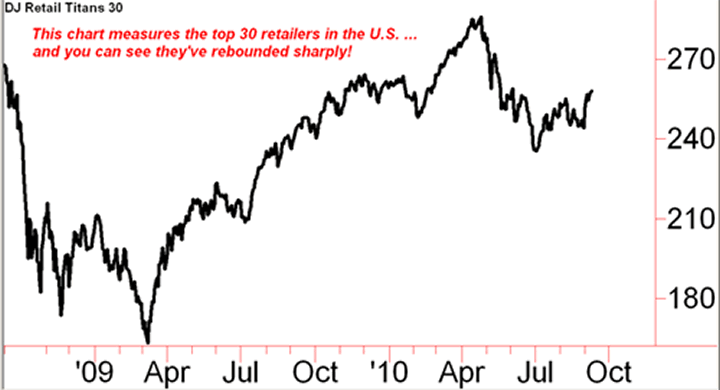An In-depth Look at U.S. Retail Stocks
Stock-Markets / Sector Analysis Sep 14, 2010 - 08:59 AM GMTBy: Nilus_Mattive
 While Americans haven’t completely abandoned their spendthrift ways, there’s no doubt that the typical shopper is thinking a lot more about their purchases … and in general, our nation is revisiting the idea of saving for a rainy day.
While Americans haven’t completely abandoned their spendthrift ways, there’s no doubt that the typical shopper is thinking a lot more about their purchases … and in general, our nation is revisiting the idea of saving for a rainy day.
I’ll discuss the broad implications of this shift some other time. Today, I’d like to talk about the specific companies most affected by our nation’s newfound frugality — the retailers.
Let’s Start with a Basic Breakdown of the Industry …
The typical newspaper article or TV reporter tends to call any store that sells goods a retailer, and that’s a fine generalization.
But as investors, it’s important for us to make more detailed distinctions … especially if we want to understand where the real dangers and opportunities are.
First on the list would be traditional department stores — the ones you used to find around your local town square, and which now typically anchor malls. Names like Nordstrom and Saks occupy the top of the hierarchy here, catering predominantly to wealthier shoppers and so-called “aspirational” buyers — the regular folks overusing their credit cards to snap up Louis Vuitton bags and designer clothes.
In the middle are the moderate department stores like J.C. Penney and Sears.
And underneath them are the discount stores — everyone from Target to 99 Cents Only Stores.
What about Wal-Mart? Although it is a discount store, Wall Street analysts technically group the company with “consumer staples” because it is so large, and sells so many necessities like groceries and health products.
|
To give you an idea of just how big Wal-Mart actually is, consider that its 2009 U.S. sales were $304 billion — 44 percent more than the next largest 14 mass merchandisers combined!
Beyond the various levels of department stores lie the specialty retailers who sell sporting goods, home and bath products, consumer electronics, apparel, auto parts, and everything in between.
Plus, there are plenty of other companies that rely on retail sales, but aren’t technically considered retailers — including fast-food restaurants, drug stores, etc.
So How Are the Different Retailers Faring in This Tricky Environment?
At the high end, Nordstrom and Saks have lost many of their aspirational buyers since lines of credit have now been all but shut off.
How are these luxury stores dealing? By catering to the truly wealthy in their flagship locations.
Meanwhile, they are also garnering more business from other shoppers through off-price stores. These can be found in outlet shopping complexes and sell clearance merchandise as well as goods bought directly from vendors. Bloomingdale’s has also decided to go this route by opening at least four outlet stores in the next year.
Other retailers farther down the food chain are finding unique ways to stay competitive, too.
Sears reintroduced layaway plans in November 2008 … and Kmart, which is now under the same corporate umbrella, also offers a layaway option in its locations.
J.C. Penney, meanwhile, has been trying to re-position itself as a more fashion-forward destination through initiatives like its in-store partnership with the Sephora cosmetics chain and a new line of clothing with Mango, a popular European fashion label.
Specialty retailers are somewhat at the whim of the specific items they carry. For example, during recessionary periods auto parts retailers often fare well as consumers choose to keep their existing cars on the road rather than trade up to new vehicles. In contrast, chains that sell home products are suffering because of the real estate bust.
And no matter what type of store you’re talking about, controlling inventory levels and other fixed costs are now critical for success in this tough environment.
Which begs the question …
Are Retailers Good Buys for Investors Now?
Let me start with a caveat: There are always companies that are doing everything right even when the big forces are going against them. And among those firms, you can usually find an undervalued stock or two.
But based on the challenges the group is facing, I don’t think most retail shares are attractive at the moment.
Take a look at the following chart …
|
As you can see, the group is up sharply off their lows reached during 2009. So in my mind, they are not currently pricing in the potential for extended economic weakness ahead.
For income investors, it’s worth noting that many retailers have managed to maintain their dividend payments throughout all the fundamental weakness. Some have even continued to increase.
But because they tend to pay below-average dividend yields, I view the very best stocks from this group as a good way to diversify a portfolio … not as income anchors.
If we see a substantial pullback in the market, especially in the more economically-sensitive groups, that could provide a good time to get more aggressive. For now, most traditional retailers aren’t on my shopping list.
Best wishes,
Nilus
P.S. I did recently recommend one company with a strong retail presence to my Dividend Superstars subscribers. But I think there are a number of circumstances that make it a major exception to what I said above. If you want the full scoop, sign up for a risk-free subscription to Dividend Superstars today. A full year of issues is only $69!
This investment news is brought to you by Money and Markets. Money and Markets is a free daily investment newsletter from Martin D. Weiss and Weiss Research analysts offering the latest investing news and financial insights for the stock market, including tips and advice on investing in gold, energy and oil. Dr. Weiss is a leader in the fields of investing, interest rates, financial safety and economic forecasting. To view archives or subscribe, visit http://www.moneyandmarkets.com.© 2005-2022 http://www.MarketOracle.co.uk - The Market Oracle is a FREE Daily Financial Markets Analysis & Forecasting online publication.





